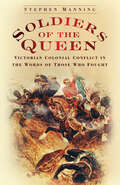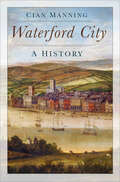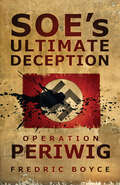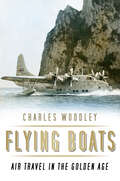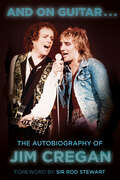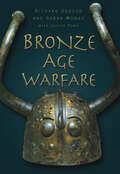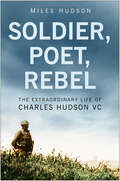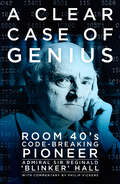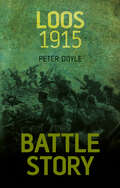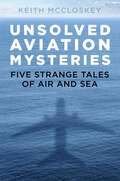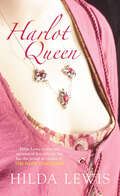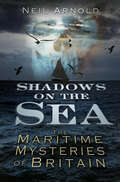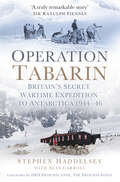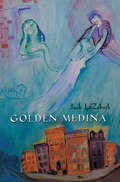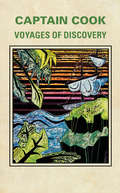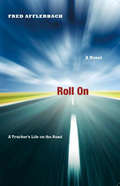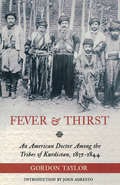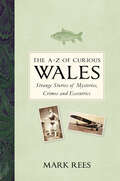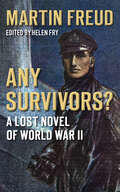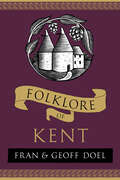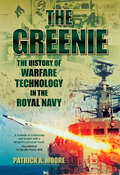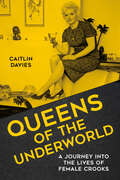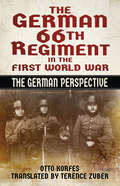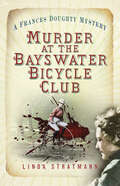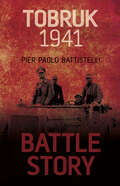- Table View
- List View
Soldiers of the Queen: Victorian Colonial Conflict in the Words of Those Who Fought
by Stephen ManningIt may come as some surprise that in such a popular area of military history there is no book that focuses on the experience of the Victorian soldier - from recruitment to embarkation, fighting and perhaps returning, perhaps dying - in his own words. Dr Manning's meticulous research in primary sources gives the lie to the received image of the disciplined, redcoated campaigner of Victorian art and literature: for one thing, by the time he arrived at his destination, the coat would have been in rags. The distances covered on march were unbelievable, through desert and disease-ravaged swamp. Lavishly illustrated throughout, all the major Colonial campaigns and most of the minor ones are featured. To understand how what was in reality a tiny standing army controlled the largest empire the world has ever seen, this book is a must.
Waterford City: A History
by Cian ManningFounded by Vikings and later earning the nickname Parva Roma (‘Little Rome’) for its religious devotion, Ireland’s oldest city has been witness to many significant historical events. From the marriage of Strongbow and Aoife to the splendour of the Georgian period, and from the first frog to be recorded in Ireland to the invention of the cream cracker, Waterford City: a History documents both momentous events and lesser-known stories. Discover the social and economic history of Waterford, and its notable characters who impacted the local, national and sometimes even the international scene.
SOE's Ultimate Deception: Operation Periwig
by Fredric BoyceIn the closing months of the Second World War, General Eisenhower exhorted the Western Allied forces to redouble their efforts to break the German will to resist. In considering this appeal, General Gubbins, whose Special Operations Executive was making a significant contribution to the liberation of occupied territory, was faced with a fundamental difficulty in the case of Germany. Although opposition to Nazism was present in some areas, it was neither organised nor pro-Allied. Then someone had the idea of creating an entirely fictional German resistance movement and 'selling it' to the Nazi security authorities. From January until April 1945, SOE rained propaganda leaflets on the hapless population fleeing the ruins of their cities and the oncoming Allied ground forces; they broadcast messages to the 'resistance'; they planted the most scandalous lies about eminent Nazis; and at the end they even dropped four agents on fictitious missions. This imaginative response to Ike's exhortation and the sheer audacity of the operation itself demand to be told to a wider audience.
Flying Boats: Air Travel in the Golden Age
by Charles WoodleyFlying Boats: Air Travel in the Golden Age sets out to do justice to a time of glamorous, unhurried air travel, unrecognisable to most of today’s air travellers, but sorely missed by some. During the 1930s, long-distance air travel was the preserve of the flying boat, which transported well-heeled passengers in ocean-liner style and comfort across the oceans. But then the Second World War came, and things changed. Suddenly, landplanes were more efficient, and in abundance: long concrete runways had been constructed during the war that could be used by a new generation of large transport aircraft; and endless developments in aircraft meant they could fly faster and for further distances. Commercial flying boat services resumed, but their days would be numbered.
And on Guitar...: The Autobiography of Jim Cregan
by Jim Cregan Andy Merriman Rod StewartJim Cregan’s career as a rock guitarist, songwriter and producer has spanned over fifty years, touring and recording albums with stars such as Elton John, Cat Stevens, Family, Willie Nelson, Steve Harley and Cockney Rebel, Joe Cocker, The Gypsy Kings, and Katie Melua. However, he is perhaps best known for his forty-year association with Rod Stewart, not only as his guitarist but also being best friends and godfathers to each other’s children.In his autobiography Jim Cregan lifts the lid on his extraordinary life, recounting his experiences with music’s biggest stars, from his first band at the age of 14 playing in youth clubs in Poole to performing in front of 350,000 people in Rio de Janeiro. In And on Guitar . . . Cregan holds nothing back: from his early life and anecdotes about his family to shenanigans on the road and extraordinary tales of hedonism, love and loss, his stories feature a Who’s Who of music’s biggest stars.
Bronze Age Warfare
by Richard Osgood Sarah MonksThe Bronze Age, so named because of the technological advances in metalworking and countless innovations in the manufacture and design of tools and weapons, is among the most fascinating periods in human history. Archaeology has taught us much about the way of life, habits and homes of Bronze Age people, but as yet little has been written about warfare. What was Bronze Age warfare like? How did people fight and against whom? What weapons were used? Did they fortify their settlements, and, if so, were these intended as defensive or offensive structures? in response to these and many other questions, Bronze Age Warfare offers and intriguing insight into warfare and society, life and death in Europe 4000 years ago. It describes the surviving evidence of conflict - fortifications, weapons and body protection, burials, human remains and pictorial evidence - and seeks to understand the role played by aggression in the prehistoric world.
Soldier, Poet, Rebel: The Extraordinary Life of Charles Hudson VC
by Miles HudsonCharles Hudson VC was one of the twentieth century's outstanding fighting soldiers. His military career through two world wars and in Russia in 1919 earned him a host of medals. He was also a man of deep feeling, an accomplished poet and, in many ways, a rebel. In this compelling biography, the author skilfully interweaves his own narrative insight with his father's wartime journals and other unpublished material. The narrative includes detailed personal descriptions of the Battle of the Somme and other actions. It recounts the authoress Vera Brittain's bitter reaction to the death of her brother Edward when under Hudson's command in Italy in 1918 and tells how Hudson, out of compassion for her feelings, did not reveal the truth until he met her in 1934. It tells of the extraordinary affair in the summer of 1940, when the Secretary of State for War, Anthony Eden, asked a meeting of senior army commanders in the then beleaguered Britain whether, in the event of a successful German invasion, their soldiers would agree to be evacuated to Canada or whether they would insist on going home to support their families. The author examines Hudson's motivation in both wars and delves deeply into his complex, and highly courageous, character.
A Clear Case of Genius: Room 40's Code-Breaking Pioneer
by Reginald Hall Philip Vickers Nigel WestIN 1933 the Admiralty banned ‘Blinker’ Hall from publishing his autobiography, but here, for the first time, those chapters that survived are presented in full. See what the renowned spymaster had to say about the British Naval Intelligence – the pinnacle of the world’s secret intelligence services. He explores the function of secret intelligence in wartime, censorship, subterfuge, the significance of Churchill in the Dardanelles campaign, the Zimmermann Telegram, the USA’s entry to the First World War and more. With supporting text and images by Philip Vickers and a foreword by expert author Nigel West, A Clear Case of Genius provides a unique insight into the thinking of one of Britain’s pioneering intelligence leaders.
Battle Story: Loos 1915
by Peter DoyleThe Battle of Loos saw a change in Allied strategy, which up until then had been a series of small-scale assaults that achieved little or no ground gained. Loos was to be different, Kitchener’s Army was deployed in strength for the first time and an ambitious plan aimed to take ground over a 20-mile front. As the fog of war descended the first day’s gains were lost over subsequent days’ fighting and in the end the ‘Big Push’ saw little achieved with Allied losses of about 50,000 men. Through quotes and maps the text explores the unfolding action of the battle and puts the reader on the frontline. If you truly want to understand what happened and why – read Battle Story.
Unsolved Aviation Mysteries: Five Strange Tales of Air and Sea
by Keith McCloskeyConspiracy theories of sabotage, murder and even UFOs flourish around the greatest unsolved mysteries of aviation from the twentieth century. This account of the most intriguing loose ends from aeronautical history provides the known details of five great mysteries and the best (and most colourful) attempts to explain what might have happened. Planes disappearing out of the sky, shady dealings with Sri-Lankan businessmen, the plummeting death of the richest man in the world in 1928 and even the Kennedy family all feature in these gripping open cases. Having previously written about the Dyatlov Pass Incident and cast his detail-oriented eye over many other aviation mishaps, Keith McCloskey now turns his attention to reassessing these five mysteries –all of which occurred over water, none of them ever resolved.
Harlot Queen
by Hilda LewisIsabella of France was proud to be wed to the handsome Edward II of England, but her joy soon turned to rancour, for Piers Gaveston, an egotistical and mercenary courtier, usurped her husband's bed. No woman could compete with her beauty, but another man? What could she do at the age of fourteen? Wait, only wait. And so she waited, nursing her anger, rejection, and disgust. She grew in beauty and wiles; the king, in weakness, as other men, worse men, took Gaveston's place. Weary of waiting, Isabella turned to Mortimer of Wigmore. In his bed, she found comfort and love and cared little that people called her a harlot. But even the presence of Mortimer could not quench her thirst for vengeance, once she had tasted blood. Like an unleashed fury, she pursued the king's paramours. She would tear England in half to quench her rage; if she failed, her son would avenge her honour. The contest that ensued decided the fate of England. In this historically accurate and thrilling story of power and passion, Hilda Lewis has created an unforgettable account of how the fate of nations has often been forged in royal bedrooms.
Shadows on the Sea: The Maritime Mysteries of Britain
by Neil ArnoldSink into the depths… The great oceans of the world have long been considered alien environments said to harbor strange creatures and unfathomable mysteries. This new book from full-time monster hunter Neil Arnold examines the maritime-rich heritage surrounding the coastline of Britain and the mysterious activity said to take place there. Shadows on the Sea explores eerie stories of phantom ships upon frothing waves, sailor’s stories, fishermen’s tales and impossible monsters said to hide within the inky depths, not forgetting weird tales of USOs – unidentified submarine-type objects – and other mysterious lights witnessed out at sea. Compiling hundreds of stories and many eyewitness accounts, from the spine-chilling to the utterly bizarre, this volume is an exploration of the unknown that takes the reader on a voyage through strange tales and roaring seas.
Operation Tabarin: Britain's Secret Wartime Expedition to Antarctica 1944-46
by Stephen Haddelsey Alan CarrollIn 1943, with the German Sixth Army annihilated at Stalingrad and Rommel’s Afrika Korps in full retreat after defeat at El Alamein, Winston Churchill’s War Cabinet met to discuss the opening of a new front. Its battles would be fought not on the beaches of Normandy or in the jungles of Burma but amid the blizzards and glaciers of the Antarctic. Originally conceived as a means by which to safeguard the Falkland Islands from Japanese invasion and to deny harbours in the sub-Antarctic territories to German surface raiders and U-boats, the expedition also sought to re-assert British sovereignty in the face of incursions by neutral Argentina. As well as setting in train a sequence of events that would eventually culminate in the Falklands War, the British bases secretly established in 1944 would go on to play a vital part in the Cold War and lay the foundations for one of the most important and enduring government-sponsored programmes of scientific research in the polar regions: the British Antarctic Survey. Based upon contemporary sources, including official reports and the diaries and letters of the participants, Operation Tabarin tells for the first time the story of this, the only Antarctic expedition to be launched by any of the combatant nations during the Second World War and one of the most curious episodes in what Ernest Shackleton called ‘the white warfare of the south’.
Golden Medina
by Jack LazebnikEarly in the twentieth century, Itkeh leaves her home in Russia for America, her innocent heart slowly developing passion as she navigates the traveler's troubles en route to the new world. Lazebnik's story is turbulent, tender, dramatic, and timeless.
Voyages of Discovery
by Captain James Cook Robert WelschBetween 1768 and 1779, Captain James Cook of the British Royal Navy made three voyages of exploration for purposes of scientific research. On each voyage he kept a log of scenes and adventures. Cook's reputation rose steadily with each voyage largely because Europeans were fascinated with the romance of discovery as well as reports of sexual licence in Tahiti and other Polynesian islands.
Roll On: A Trucker's Life on the Road
by Fred AfflerbachRoll On celebrates the freedom of the open road. The reader rides shotgun in an aging yet durable Peterbilt diesel rig on an interstate odyssey with longtime independent truck driver, Ubi Sunt. Traversing the Painted Desert, the Black Hills of South Dakota, and through the nation's breadbasket into the gritty northeast, you will meet misfits, wayfarers and dreamers . In the literary tradition of escape and return, and journey to enlightenment, Ubi faces tough choices. The highway is home but the road is changing. And his only daughter offers an ultimatum: Settle down or else.
Fever and Thirst: An American Doctor Among the Tribes of Kurdistan, 1835-1844
by Gordon TaylorThe first Americans to work with the people of the Middle East were neither spies nor soldiers. They were, in fact, teachers, printers, and missionaries; and one was a country doctor from Utica, NY. In June of 1835 Asahel Grant, M.D. and his bride, Judith, sailed from Boston to heal the sick and save the world. Fever and Thirst tells the story of Asahel Grant: explorer, physician, author and the first American to become enmeshed in the struggles of northern Iraq.
The A-Z of Curious Wales: Strange Stories of Mysteries, Crimes and Eccentrics
by Mark ReesWales' history is packed with peculiar customs and curious characters. Here you will discover alien landscapes, ancient druids and a Victorian ghost hunter. Find out why revellers would carry a decorated horse’s skull on a pole door to door at Christmastime, how an eccentric inventor hoped to defeat Hitler with his futuristic ray gun, and why a cursed wall is protected by a global corporation for fear it might destroy a town. From the folklore surrounding the red dragon on the flag, to the evolution of the song ‘Sosban Fach’, this compendium of weird and wonderful facts will surprise and delight even the most knowledgeable resident or visitor.
Any Survivors?: A Lost Novel of World War II
by Martin Freud Helen FryIn 2008 a faded typescript was discovered in a suitcase in the attic of one of Martin Freud's grandchildren. It was a satirical novel about the Second World War written by Sigmund Freud's son Martin, but never published and apparently forgotten about. Freud and his family had escaped from Nazi-occupied Vienna in 1938, narrowly avoiding losing everything, including their lives. Arriving in England, Martin, formerly an eminent lawyer in Vienna, was interned as an 'enemy alien,' and later ran a shop near the British Museum (his son, Walter, fought for the British in the SOE during the war). It is known that Martin wrote numerous poems and pieces of fiction, but the only books he ever published were a fictionalised account of his experiences during the First World War, Parole d'Honneur, in 1939 and an autobiography, Glory Reflected, in 1957. Now translated into English and published for the first time, Any Survivors? is not only a satirical and dramatic novel about a refugee who returns to Hitler's Germany as a rather inept spy, but also the testament of a man who lived through the most dramatic moments of this period as part of a famous and fascinating family.
Folklore of Kent (Folklore)
by Fran Doel Geoff DoelKentish folklore reflects the curious geography and administrative history of Kent, with its extensive coastline and strong regional differences, which are reflected in distinctive cultural traditions. Bounded by sea on three sides, Kent has the longest coastline of any English county and was the base for much maritime activity, giving rise to communities rich in sea-lore.Fran and Geoff Doel explore the folklore, legends, customs and songs of Kent and the causative factors behind them. From saints to smugglers, hop-pickers to hoodeners, mummers to May garlands and wife sales to witchcraft, this book charts the traditional culture of a populous and culturally significant southern county.
The Greenie: The History of Warfare Technology in the Royal Navy
by Patrick A MooreIn the Royal Navy vernacular, the term 'greenie' describes the officers and ratings responsible for the electrical engineering functions of the fleet. Electrical engineering has 'driven' the Royal Navy for far longer than one might imagine, from solving the problem of magnetic interference with the compass by the ironclad early in the 20th century onward. Author Commander Moore traces the development of technology from 1850 to today's integrated micro computers that control almost every aspect of navigation, intel, and strike capacity. At the same time, he describes how the Navy's structure and manpower changed to accommodate the new technologies, changes often accelerated in wartime, particularly in World War II. Without the full cooperation of naval establishments and organisations and various public and private museums and manufacturers, this work would have been impossible to produce. Written in an anecdotal, narrative style but with a complete mastery of the science itself, it will appeal not only to those interested in the history of the Royal Navy but also those many thousands, past and present, who can claim the honour of calling themselves one of the Greenies.
Queens of the Underworld: A Journey into the Lives of Female Crooks
by Caitlin Davies‘What a brilliant piece of research; pieced together with compassion, heart and understanding. Caitlin gives voice to women who have been forgotten or have only been seen through a male prism. She wrestles back their stories’ - Maxine Peake‘A rollicking account of all kinds of crime committed by women . . . who have not only been forgotten or ignored, but who put their male criminal counterparts to shame’ Julie Bindel, The SpectatorRobin Hood, Dick Turpin, Ronnie Biggs, the Krays . . . All have become folk heroes, glamorised and romanticised, even when they killed. But where are their female equivalents? Where are the street robbers, gang leaders, diamond thieves, gold smugglers and bank robbers?Queens of the Underworld reveals the incredible story of female crooks from the seventeenth century to the present. From Moll Cutpurse to the Black Boy Alley Ladies, from jewel thief Emily Lawrence to bandit leader Elsie Carey and burglar Zoe Progl, these were charismatic women at the top of their game. But female criminals have long been dismissed as either not ‘real women’ or not ‘real criminals’, and in the process their stories have been lost.Caitlin Davies unravels the myths, confronts the lies and tracks down modern-day descendants in order to tell the truth about their lives for the first time.
The German 66th Regiment in the First World War: The German Perspective
by Otto Korfes Terence ZuberGerman Infantry Regiment 66 fought in most of the great battles on the Western Front in the First World War: Le Cateau, First Marne, Arras 1915, the Somme, Chemin des Dames 1917, the German March 1918 offensive, Chemin des Dames 1918, Second Marne and the Siegfried Line. This is the official regimental history, written in 1930 by Major Dr Otto Korfes, an officer in the regiment for most of the war and a Reichsarchiv historian.The German 66th Regiment in the First World War presents a unique insight into the German Army during the Great War, showcasing a perspective all too often ignored. Translated by German Army expert Terence Zuber, it includes maps and pencil sketches by the famed German war artist Döbrich-Steglitz. Containing a viewpoint that will add balance to anyone’s knowledge of the events of 1914–1918, this volume is a must-read for military historians and enthusiasts alike.
Murder at the Bayswater Bicycle Club: A Frances Doughty Mystery 8
by Linda StratmannLondon, 1882: In this her final case, Frances Doughty goes undercover for Her Majesty's Government to investigate some disturbing information regarding the apparently innocuous Bayswater Bicycle Club. Before long she is plunged into a murky world of deadly secrets, a suspicious disappearance, and a brutal murder, and the Lady Detective is forced to do the unthinkable to prevent becoming the next victim. With a new and exciting future lying before her, is there anything the dauntless Miss Doughty cannot do?
Battle Story: Tobruk 1941
by Pier Paolo BattistelliThe siege of Tobruk lasted 240 days during which the ‘gallant garrison’ of Allied soldiers, including the famous ‘Desert Rats’ held out against constant attacks from Rommel’s Afrika Korps. The battle became one of the longest sieges in British military history and a potent symbol of British resistance. To understand what happened and why – read Battle Story. Diary extracts and quotes offer a real insight into what it was like for the Allied soldiers to live under siege. Maps highlight the adversities of the terrain and the strategic importance of the Tobruk fortress. Rare photographs place you on the frontline of the unfolding action. Orders of battle reveal the composition of the opposing forces’ armies. Packed with fact boxes, this short introduction is the perfect way to explore this important battle.
